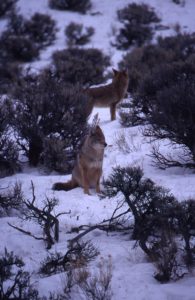The cry of the wolf may be older than mankind. To some it’s the music of nature while others tremble in fear. Coyotes and wolves rarely attack humans, yet the sound of those escalating notes signal that a predator is in the vicinity and ready to kill.
How different the wolf howl than an elk bugle. Where as one excites and entices a hunter to begin the chase, the howl of the wolf communicates that you may be the prey.
Elk Camp Return
 If you are an Easterner and not accustomed to hearing coyotes and wolves howl, the sound can be frightening, especially if you are alone. I once operated an elk camp in the White River National Forest and had six friends in camp with me. As darkness fell, one member didn’t show up at camp and we began to worry about him. Six inches of snow had fallen during the day and we hoped all was well. Suddenly, he burst into the tent, completely out of breath.
If you are an Easterner and not accustomed to hearing coyotes and wolves howl, the sound can be frightening, especially if you are alone. I once operated an elk camp in the White River National Forest and had six friends in camp with me. As darkness fell, one member didn’t show up at camp and we began to worry about him. Six inches of snow had fallen during the day and we hoped all was well. Suddenly, he burst into the tent, completely out of breath.
Eventually, our conversation focused on the coyotes howling in the background and my buddy didn’t say very much. The next morning, as we traveled the main trail from camp we saw his foot prints… about four feet apart. Even carrying a rifle, he was “alarmed” and literally ran back to camp.
Enjoy the sound of the wolves. Feel free to mentally punctuate the report of a .223.
They say a pack that howls together, stays together. This pack, housed at the captive wolf facility on the Sevilleta Wildlife Refuge in New Mexico is made up of AF1323 and AM1336 with their pups mp1602 and mp1603. These two pups are part of the over 60 Mexican wolf pups born in this year's captive breeding program
Posted by U.S. Fish & Wildlife Service Southwest Region on Tuesday, July 11, 2017



















![The Best Deer Camp Chili [VIDEO] Deer Chili Ingredients, Tomatoes, Chili Spices](/wp-content/uploads/2015/10/Deer-Chili-Deer-Camp-Recipe-218x150.jpg)
![How to Call Elk Early in the Season [VIDEO]](/wp-content/uploads/2016/08/byers003-218x150.jpg)



![Idiots Disturb Hunter: How Would You Have Handled It? [VIDEO]](/wp-content/uploads/2015/10/DSC00110-e1474487693878-100x70.jpg)
![Albino Buck Shocked to Shed His Antlers [VIDEO]](/wp-content/uploads/2015/10/AlbinoDeer-100x70.jpg)